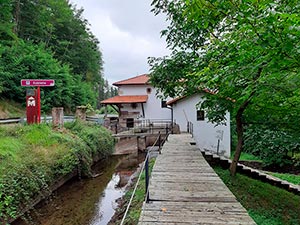Hydroelectric power plants in the Bidasoa basin
Zubieta Mill
The Zubieta mill is located next to the NA-170 road that connects Doneztebe with Leitza, just before the access detour to the village. The water from the Ezkurra river reaches the mill through a canal almost three hundred meters long, next to which a path has been laid out that allows the visitor to observe the course of the water from its catchment and the old washhouse.
This is an example of a flour mill converted to the production of electricity for local consumption, as happened at the beginning of the 20th century in most of the towns of Navarre. These small electras would disappear from the 1960s, unable to cope with the growth of industrial and domestic demand. The one in Zubieta has medieval origins, although it was rebuilt in 1785, as the lintel of the access door testifies. In 1903 it incorporated an electric turbine in a pavilion annexed to the mill, which would continue with its wheat and corn milling activity. Electricity production continued until 1966. During this period, the property corresponded to a society of shareholders in which a good issue of neighbors of the town participated.
Today the mill has been transformed into an ecomuseum, a rehabilitation work by Maite Apezteguía Elso (1999) that has been awarded and praised by architecture professionals. This museum concept implies, among other things, the preservation of traditional activities with the direct participation of the local community. In this case a guided visit is offered in which the miller's official document is explained live, as the milling facilities are still in use. The tour continues in the area of the old miller's house with an evocation of the daily life of the village through audiovisuals and a exhibition of ethnographic pieces, and concludes by surprising the visitor with the turbine that produced electricity.
In the same municipality of Zubieta, less than a kilometer upstream from the mill, you can visit one of the first large hydroelectric power plants in the Bidasoa basin, commissioned in 1906. It is a building of notable dimensions formed by a conference room of machines of marked horizontal development , that houses two groups of generation, and a vertical pavilion of three heights attached in one of the ends. Known as the "Zubieta power station", it was dedicated to supplying the San Sebastian to Hernani Railway Company through a line that reached Guipuzcoa through Goizueta.
ALEGRÍA SUESCUN, D., "El molino harinero de Zubieta. Evolución histórica", in Notebooks of ethnology and ethnography of Navarren.º 82 (2007), pp. 5-15.
APEZTEGUÍA ELSO, M. and IRIGARAY SOTO, S., "El Ecomuseo del Molino de Zubieta (Navarra): experiencia pionera en la recuperación y musealización de una instalación preindustrial", in Museum: Magazine of the association Profesional de Museólogos de España (Professional Association of Museologists of Spain)No. 4 (1999), pp. 181-192.
BERAZALUCE ELCARTE, M., "La industria hidro-eléctrica en Navarra", in Rafael Guerra (ed.), Navarra. Ayer, hoy y mañana, Pamplona, Diputación Foral de Navarra, 1933.
HERREROS LOPETEGUI, S. (coord.), Centrales Hidroeléctricas en Navarra (1898-2018), Pamplona, Gobierno de Navarra, 2020.
Map of status based on El agua en Navarra, Pamplona, Caja de Ahorros de Navarra, 1991.











